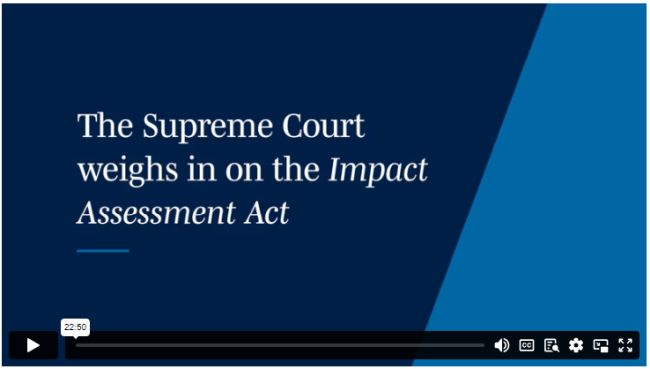- with Senior Company Executives, HR and Finance and Tax Executives
- with readers working within the Banking & Credit, Insurance and Healthcare industries
The highly anticipated decision of the Supreme Court of Canada that the federal government's impact assessment framework exceeded its constitutional bounds1 has made headlines and sparked discussion among business and industry. The ruling also sends legislators back to the drawing board for significant parts of the far-reaching regime.
In this article and video, we share our initial reactions and commentary on the landmark ruling.
Video: The Supreme Court weighs in on the Impact Assessment Act
Video transcript
What stood out about the case to our litigators? Litigation partner Andrew Bernstein described the federal government's "novel" argument as: "'Well if you squint and look at it sideways and read [the Act] as actually limited to federal effects—judge the legislation on how it's administered, not what it says—then it is constitutional ... that is not an argument that's typically accepted in Canadian constitutional law". Litigation partner Yael Bienenstock noted that although the Court ultimately sided with the Alberta Court of Appeal, it nonetheless went a long way to avoid engaging many of the Alberta Court of Appeal's very good points, including with respect to the relevance of the history of provincial powers in the Canadian constitution. She noted that "usually you see the court either saying where the [court below] went wrong or agreeing with certain aspects of what happened below", and here they don't.
Much of the conversation turned to what happens next for projects across the country. It's the business impact for project proponents that litigator and Calgary managing partner Lou Cusano highlighted. "It's interesting that although the fight was led by Alberta, the implications of the decision are country-wide ... as you look across the country, there are implications, for example, for LNG facilities in B.C., bitumen projects in Alberta, mining in a number of provinces, even down to highway 413 in Ontario. Whether or not projects shelved under the Act may be revisited remains to be seen".
Environmental partner Dennis Mahony observed the decision will narrow the federal role in approving projects. "With respect to primarily provincially regulated projects, that gatekeeper function is much, much narrower and that will need to be reflected in the" revisions to the Act the federal government is probably already working on. "There will of course continue to be federal aspects to those projects and some federal role, but for provincially regulated projects, they should be a secondary sliver, not the main driver".
He also sees the recent decision in the context of the Court's decision on another key component of the government's environmental policy: the Greenhouse Gas Pollution Pricing Act. In that case, he said, "the federal government's legislation got a thumbs up with the reminder that its power was not without constraints. [In the IAA case], that reminder got an exclamation point with a thumbs down from the Court" for the legislation.
The decades-long history of federal environmental assessment
Federal environmental assessment legislation has existed for many decades. The latest iteration—the Impact Assessment Act (the IAA)—was enacted in 2019. The IAA sets out a complex scheme for information gathering, approving, and regulating physical activities or projects that may have environmental or health, social or economic effects on matters within federal jurisdiction. This includes a wide ambit of matters, including airports and interprovincial works and undertakings such as interprovincial railways and pipelines. However, the IAA also regulates federal "aspects" of projects, like mines, that are primarily under provincial jurisdiction. Those aspects include Indigenous peoples and federal lands, fish, aquatic species, migratory birds, as well as interprovincial or international environmental effects2.
The heart of the IAA is a scheme that can be referred to as "designation, prohibition and assessment". Projects that are designated as falling within the scheme are prohibited from proceeding until the assessment is complete, and the relevant federal decision maker has approved it.
Under the IAA, projects are "designated" in one of two ways: (1) because they involve certain physical activities identified in the IAA's Regulations as potentially having adverse environmental or health, social or economic effects on areas of federal jurisdiction; or (2) by order of the Minister of Environment and Climate Change Canada, if the Minister believes the project could cause adverse federal effects3.
Once designated, the project enters the planning and assessment phases, during which the project proponent is effectively prohibited from proceeding4. The Minister and the Governor in Council then decide whether, in light of the results of the assessment, the project should receive permission to proceed—and if so, what conditions should apply to mitigate the effects of the project5. For a project to proceed, the decision maker must decide that the effects in question are in the public interest.
The Supreme Court's decision
Majority: IAA is ultra vires, in part
The majority of the Supreme Court concluded that the portion of the IAA pertaining to projects on federal land or land outside Canada is intra vires the powers of federal Parliament6. However, it found the core of the act—pertaining to "designated projects"—is ultra vires7. The Court acknowledged that although environmental protection is clearly important, it must be accomplished "within the enduring division of powers framework laid out in the Constitution". And it confirmed that, although flexibility and cooperation are important aspects of federalism, they are not an excuse to override or modify the division of powers.
The Court conducted the well-established "pith and substance" analysis, which seeks to characterize the "main thrust" of the law by examining its purpose and its effects. Once that is determined, the question is whether the law should be classified under a federal or provincial head of power. It held that the pith and substance of the "designated projects" aspect of the legislation was assessing and regulating designated projects with a view to mitigating or preventing their potential adverse environmental, health, social, and economic impacts8. It concluded that this is ultra vires federal legislative authority, because the "designated projects" scheme is insufficiently tailored toward regulating "effects within federal jurisdiction"9. The scheme does not distinguish between activities where Parliament has broad jurisdiction over the activity itself (e.g., interprovincial pipelines) and those where Parliament only has limited jurisdiction over the activity's impacts on federal heads of power (e.g., a provincially regulated mining project with the potential to impact fisheries). Although Parliament can pass legislation to regulate the latter category, it must ensure that the dominant characteristic of the legislation is regulation of the federal aspects of a project, and not the project as a whole.
The Court concluded that the "designated projects" scheme fell short in two key ways.
First, even though "federal effects" are required to trigger the scheme, they do not, on the terms of the Act, drive decision-making, nor is the scheme directed only at regulating federal effects. For example, in making the initial screening decision—whether an assessment is required under the IAA—the legislation provides for broad discretion to consider an open-ended list of factors, a number of which are unrelated to federal effects. However, once a federal effect is asserted, the government looked at the project as a whole, and was not confined to looking at the federal effect. Canada argued that, in practice, the most important factors are the federal effects. But the Court rejected this argument since that is not what the legislation actually says. The Court concluded that the scheme is constitutionally problematic because it creates "a risk that projects with little or no potential for adverse federal effects will nonetheless be required to undergo an impact assessment on the basis of less relevant, yet mandatory, considerations"10.
Similarly, at the final approval stage, the IAA stipulates that the decision must be made in the "public interest", which expressly requires the decision-maker to consider a variety of federal and non-federal effects. The Court was particularly concerned that "the adverse non-federal effects can amplify the perceived severity of the adverse federal effects and, effectively, become the underlying basis for the conclusion that the latter are not in the public interest"11. This framework shifts the analysis away from deciding whether the adverse federal effects are justified (which was the regime under the IAA's predecessor statute) and instead directs it to the wisdom of proceeding with the project as a whole.
Second, the Court was concerned with the definition of "effects within federal jurisdiction," and its potential for influencing the broad decision-making elements of the IAA12. For example, some effects defined as "effects within federal jurisdiction" effectively captured "an unlimited range of interprovincial environmental changes" such as greenhouse gas emissions that cross provincial and national borders13. Although the federal government attempted to justify the breadth of this definition under the Peace, Order and Good Government (POGG) power, the Court rejected this argument based on the sheer breadth of the IAA (in contrast to the limited regulatory regime of carbon pricing it had previously upheld under POGG).
In sum, the Court held that the "designated projects" scheme intrudes more than incidentally into provincial legislative authority, including property and civil rights in the province, matters of a local nature, local works and undertakings, and non-renewable resources, forestry resources and electrical energy. It was therefore ultra vires Parliament.
Dissent: would have upheld the IAA
Justices Karakatsanis and Jamal would have upheld the legislation as intra vires the federal power. Their reasons emphasized the value of cooperative federalism and the presumption of constitutionality.
Looking ahead
Since this was a reference, which is an advisory opinion from the Court, the "designated projects" aspect of the IAA has not been "struck down". However, in light of the strong persuasive value of the Supreme Court of Canada's decision, project proponents can expect material changes to the federal assessment regime. To pass constitutional muster, the next iteration of the legislation will require more emphasis or focus on the federal effects analysis for projects that are primarily provincially regulated. Still, the federal government indicated in its reaction to the decision that it foresees tweaks rather than transformation. Whatever the case, under future iterations of the IAA, fewer projects may be designated for federal assessment than there would have been under the former IAA.
Footnotes
1. 2023 SCC 23 [IAA Reference].
2. IAA, section 2.
3. IAA, sections 109(b) and 9(1).
4. IAA, section 7(1).
5. IAA, sections 60-64.
6. See IAA, sections 81-91.
7. Reference re: IAA at para 207.
8. Reference re: IAA at para 91.
9. Reference re: IAA at paras 151 and 154.
10. Reference re: IAA at para. 154.
11. Reference re: IAA at paras 169 and 175.
12. Reference re: IAA at para 179.
13. Reference re: IAA at para 184.
The content of this article is intended to provide a general guide to the subject matter. Specialist advice should be sought about your specific circumstances.





